Recently, I posted some observations and theories that I have been developing on citrus gall wasps. To test out the theories, I’m setting up a trial to see which treatment regime might produce the healthiest and most productive trees.
Setting up the gall wasp experiment
In August 2017 I purchased 10 Meyer lemon trees. At the time of purchase, they were relatively identical in size, shape and stage of growth. The trees were randomly paired up and allocated to five different treatments:
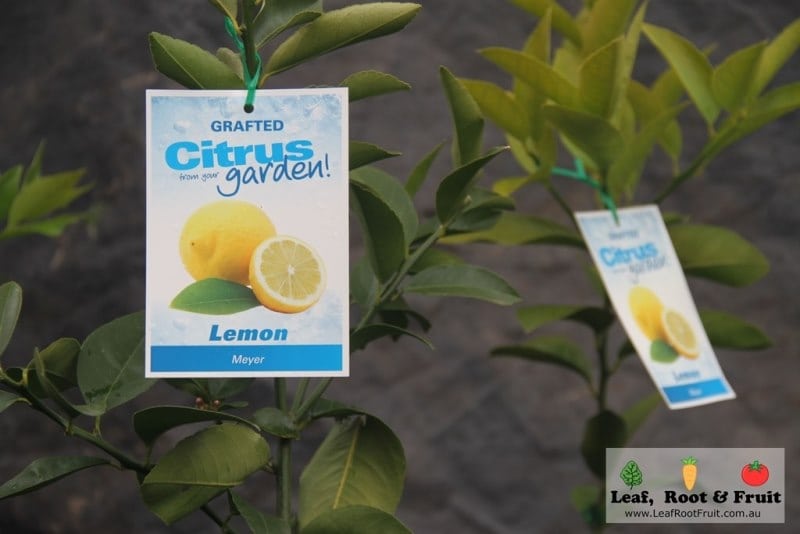
- Treatment 1: Citrus Galls pruned out in June every year, fertilised monthly Sep to May.
- Treatment 2: Citrus Galls pruned out in June every year, fertilised monthly in Dec and Jan only.
- Treatment 3: Citrus Galls not pruned out, fertilised monthly Sep to May.
- Treatment 4: Citrus Galls not pruned out, fertilised monthly in Dec and Jan only
- Treatment 5: Citrus Galls not pruned out, fertilised monthly Sep to May and treated with calcined kaolin clay (Surround®).
The trees were potted up into 40 cm pots and filled with Fulton’s Bulk potting mix. I chose Fulton’s Bulk potting mix as it was an average performer in my recent potting mix trials. This meant that I could control the amount of nitrogen rich fertiliser, that I applied during the first few seasons of growth. A better performing potting mix would have promoted a flush of spring growth regardless of any extra fertiliser that we applied.
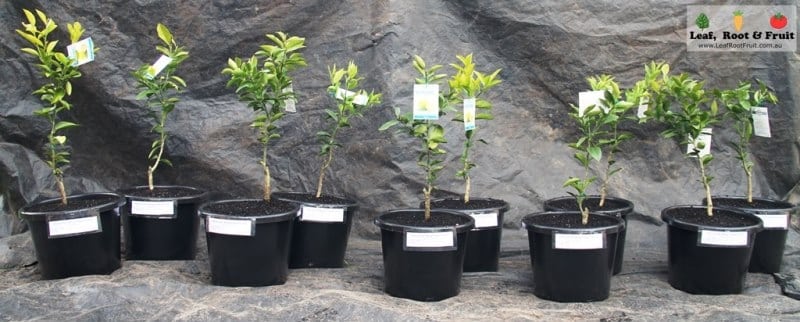
The plants were placed together to ensure that all experienced similar growing conditions, sunlight, microclimate and irrigation.
There are several large citrus trees growing less than 50 metres from where the experiment is set up. There are other citrus trees visible in nearby neighboring yards. They are all likely to have some Citrus Gall Wasp in them.
Citrus tree pruning regime
Treatments subjected to the “Prune in June” regime (four trees in total) are to have all visible galls pruned from the tree in June. The galls are to be soaked in a bucket of water. None of the purchased trees had any galls present when purchased. I decided to mimic trees that have been infected to speed up the accumulation of results. So approximately one third of the foliage was removed from the trees subjected to the June pruning regimes (despite there being no galls present in the first year). The other six trees will not be pruned at all in June, in any year.

All ten trees will be tip pruned as required in/or around November and again in/or around February (if required). Whilst the trees are small, this will be done with secateurs or finger tips. As the trees grow, I may resort to using hedge trimmers. Pruning will aim to retain as much fruit and blossom on the tree as possible. This pruning is a typical regime that I use on most citrus trees (see my guide on citrus tree pruning for further details)
Fertilising Regime
Trees are to be fertilised according to one of the following two regimes
- monthly Sep to May
- monthly in Dec and Jan only
Trees are fertilised with Richgro Organic Fruit and Citrus Fertiliser, which was the best performing organically certified fertiliser in my recent experiment.
It will be applied at the rate of one handful per pot, per month. The fertiliser will be scattered around the surface and then watered in well.
Calcined Kaolin Clay (Surround®) Regime
The NSW DPI has been trialling some different treatments in commercial citrus orchards. One organic treatment method is showing promise. It involves spraying calcined kaolin clay (Surround®) twice during the citrus gall wasp emergence period. This disrupts the laying of eggs and has shown to reduce gall occurrence significantly. We’ve decided to include this treatment as it’s relatively inexpensive, easy to apply and it’s organic.
Calcined Kaolin Clay (Surround®) is to be applied fortnightly for a total of three applications. The first application is to occur in spring at the start of each October. UPDATE 05/12/17: Going forward we will adjust the application of spraying the kaolin clay treatment so that we spray fortnightly applications four times, with the first application in the third week of October (see December 2017 update below)
It is to be applied at the “sunburn rate”. To do this we mixed 8 spoonfuls of power in a small jar of water. This was then tipped into a sprayer and made up to a final volume of 2 litres by adding more water. The trees are to be moved away from the other trees for treatment. The clay is applied using the sprayer and allowed to dry before being returned to their usual position.
Results of my Citrus Gall Wasp control experiment
Update December 2017
The peak emergence for Citrus Gall Wasp in Melbourne looked to occur on (or around) the 28 November 2017. I filmed the above video of wasps emerging from galls on my tree and mating. I monitored the developing galls and when emergence was imminent we moved all ten trees around the perimeter of my infested grapefruit tree.
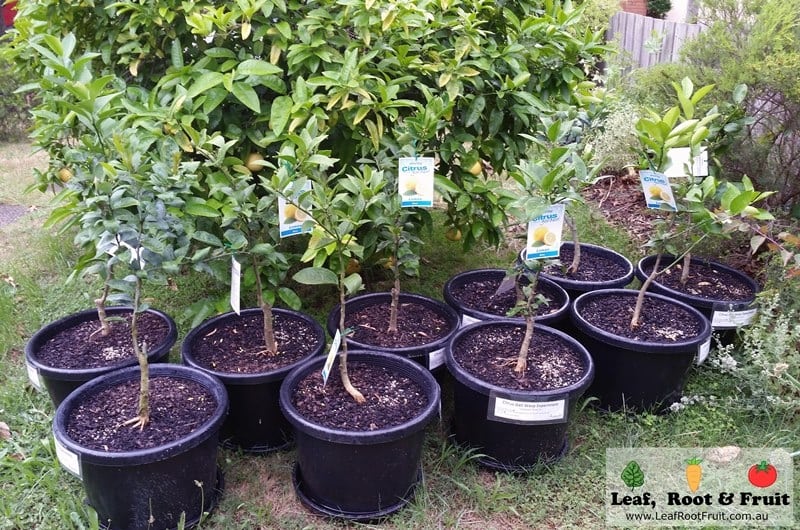
The emergence date was about a fortnight later than I had expected. I had based my expected emergence date on NSW data. Future years’ emergence dates for Melbourne are also likely to be around the same time (late October-early December) Going forward I will adjust the application of spraying the kaolin clay treatment so that I spray fortnightly applications four times, with the first application in the third week of October.
The kaolin treatment from this year is likely to be ineffective against the gall wasp. Particularly with tree 5A, as it had a flush of new growth since the final Kaolin application. That new growth had no kaolin on it, leaving it susceptible to infection. I expect this tree to have at least a few galls evident next year.
The following trees had lots of new growth at the time of peak emergence. I expect that they will have a large amount of infestation next year:
1B, 2B, 4B, 5A
The following trees were absent of much new growth at the time of peak emergence. I expect that they will have very little infestation next year.
1A, 2A, 3A, 3B, 4A, 5B

At this stage there is no correlation between the amount of new growth and either fertilising or pruning regimes. I expect this is because the experiment has only been set up in the last three months. Next spring, once the trees have settled into their growing cycles, a correlation will hopefully be more evident.
All trees have some small fruit set. Tree 2A has the biggest and strongest crop.

Update June 2018
June is the traditional time to prune out gall wasp. So trees being subjected to Treatment One and Two had their galls pruned out in the last week of June.
At the same time as undertaking pruning I noted lots of observations for each tree. These have been tabulated below.
The following points from this round of observations are most interesting:
- Trees that have been feed monthly from Sep to May had an average of 2.5 mature lemons per tree vs only 1 mature lemon on average for the trees fed Dec and Jan only. So reducing fertilising seems to impact productivity significantly.
- Two treatments did not have any gall wasps present. They were treatment 4 (the reduced fertiliser and no gall removal) and treatment 5 (kaolin treatment)
- Feeding regimes did not seem to have an impact on susceptibility to Pink scale or induction of flowering.
- Feeding regimes did not seem to have an impact on susceptibility to Citrus Leaf Miner. In fact, the most severely affected tree was on the reduced fertilising regime.
- The kaolin treated trees showed no impact of Citrus Leaf Miner whatsoever. I hope that some residual clay from the previous October/November has interrupted the life cycle of the moth (rather than it just being a coincidence). I am particularly keen to see what happens next autumn with the two trees undergoing the Kaolin treatment regime.






| Tree Number | Number of Citrus Galls present in tree | Leaf Miner evident in Tree | Number of mature, ripe lemons on tree | Number of immature, second crop lemons on tree | Leaf Condition | Other comments |
|---|---|---|---|---|---|---|
| 1A | 2 x small | Moderate | 4 | 0 | Dark leaves, new growth is lighter in colour | Flowers starting to form. Pink scale evident |
| 1B | 1 x small | Very little | 1 | 1 | Slight yellowing. New growth has been slightly burnt by frost | Flowers starting to form. Pink scale evident |
| 2A | 4 x small 1 x large | Severe | 4 | 0 | Light green coloured leaves | Pink Scale Evident |
| 2B | 4 small | Moderate | 0 | 3 | Slight yellowing but generally dark green leaves. | Pink Scale Evident. Ladybug present. |
| 3A | 5 small | Very little | 5 | 0 | Dark green leaves. Lots of new growth | Lady bugs present, NO scale. |
| 3B | 3 small | Very little | 1 | 0 | Several leaves are yellow, otherwise mostly dark green | Lots of flowers, NO scale |
| 4A | none | Moderate | 0 | 0 | Slight yellowing of leaves, mostly light green | Pink Scale Evident |
| 4B | none | Very little | 0 | 0 | Moderate amounts of yellowing in leaves | Lady Bug present, Pink scale evident |
| 5A | none | None | 3 | 0 | Slight yellowing of leaves, mostly dark green | Pink Scale, Brown scale and Ant present |
| 5B | none | None | 2 | 0 | Slight yellowing of leaves, mostly dark green | Flowers starting to form |
It is going to be interesting to continue observing the results of the trial. So far, the most promising results have been with the Kaolin treatment. However, we are only a year into the trial, so who knows what the coming years will bring?
Update December 2018
The gall wasps in our grapefruit, lemon and orange trees began to emerge in large numbers on 2nd December. This particular day was hot and windy. The high winds will help to disperse the wasps to infest other trees in the area. I suspect they may travel hundreds of metres, if not kilometres in the wind.
The 2018 peak emergence is three days later than 2017. Which shows just how much these wasps behave like clockwork. It also shows why “Prune in June” is such terrible timing for controlling the problem.
I noticed that wasps continued to emerge from local trees for most of December. Many galls stayed dormant and haven’t had any wasps emerge. I haven’t noticed this in previous years, but will look out for it more in the future. I suspect that this may be due to sterile eggs being laid under the bark. Perhaps this is enough to stimulate the tree to form a protective gall even though the eggs are not viable?
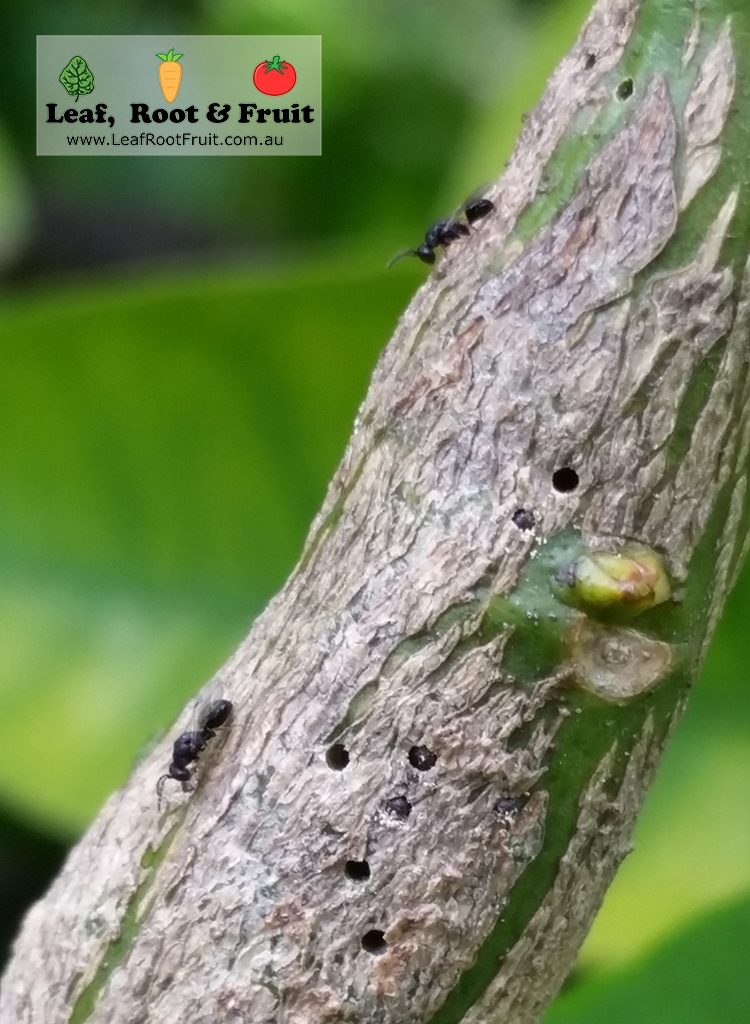
Update June 2019
My gall wasp experiment is now two years old and I am starting to see some trends.
I recently moved all the trees into the warehouse to inspect them. Outcomes from these inspections are shown in the table below. During the inspection, I looked at the number of galls on each tree, the quantity of fruit and other observations such as incidence of pests.

After the initial inspection I performed the “prune in June” to the trees undergoing treatment one and two.

Fruit were then harvested from the tree. Interestingly some of the trees (especially treatment 3) had lots of fruit, but they were very small. So I also weighed the total quantity of fruit harvested for each treatment.
| Tree Number | Number of Citrus Galls present in tree | Leaf Miner evident in Tree | Number of mature, ripe lemons on tree | Total Weight of Crop for both trees (Kg) | Other comments |
|---|---|---|---|---|---|
| 1A | 7 | Moderate | 1 | ||
| 1B | 5 | Moderate | 14 | 1.71 kg | |
| 2A | None | Moderate | 3 | ||
| 2B | 3 | Very little | 8 | 1.10 kg | |
| 3A | 10 | None | 7 | 1 x fruit smaller than most | |
| 3B | 3 | Very little | 14 | 1.09 kg | All fruit small |
| 4A | 2 | Moderate | 10 | ||
| 4B | 4 | Moderate | 11 | 2.08 kg | |
| 5A | 1 | Moderate | 16 | ||
| 5B | None | Moderate | 10 | 2.76 kg |
There were a few interesting observations that I made about my citrus gall wasp experiment this year:
- Fertilising regimes had a small impact on the quantity of fruit harvested, but didn’t have the clear cut influence that was observed last year. Could this be due to biennial cropping beginning to occur in the trees on the high fertiliser regimes?
- The trees NOT undergoing the “Prune in June” approach are generally larger in size than those being subjected to prune in June (especially after this treatment was carried out). The trees not subject to prune in June also had slightly more fruit (by weight and total number
- All trees except for two (2A and 5B) had galls present. Treatments One and Three both had large numbers of galls compared to the other treatments. The Kaolin treatment (Number 5) only had one small gall between the two trees.
- All trees were suffering from scale regardless of their treatment
- The Kaolin treatment (Number 5) still continues to be the most positive treatment regime. It had the least number of galls (only one) and by far the highest yield of fruit (both in number and by total weight)
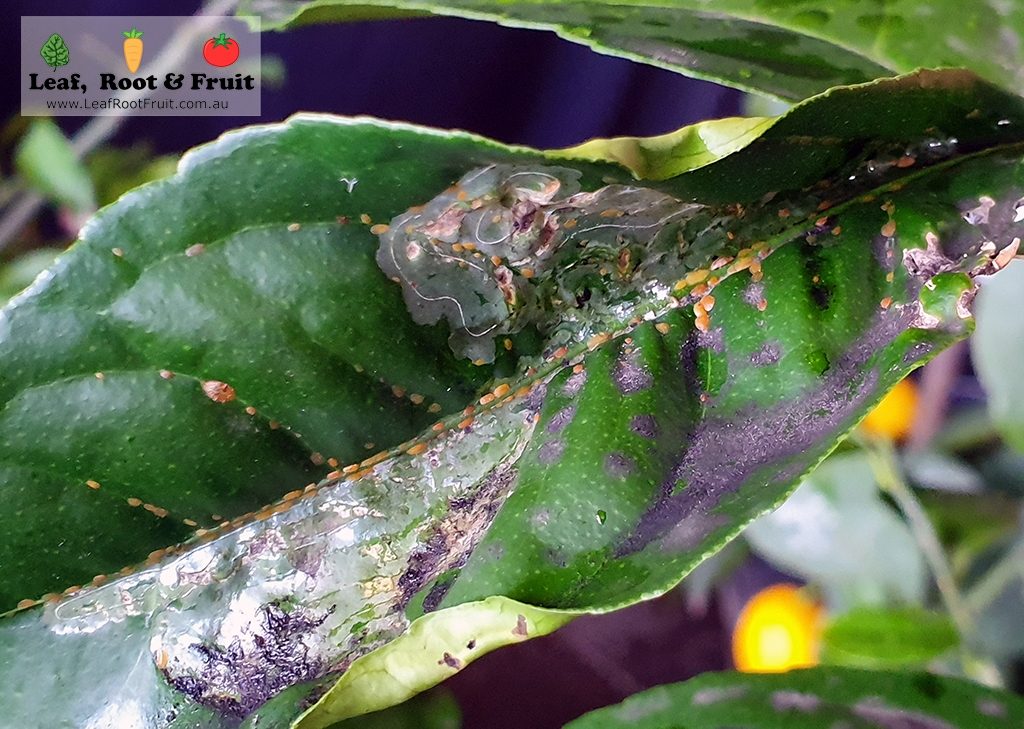



Update December 2019
The feedback shared by the community, on my social media posts has been very interesting. Some of you indicated that wasps started emerging in late November in 2019. My wasps, and those from many other trees across Melbourne emerged on the 7th December and continued to emerge for the following fortnight.
Based on the last three years of data it looks like the gall wasp emerges over the space of around 3 to 4 weeks in Melbourne, from late November to early December.
Update June 2020
My gall wasp experiment was inspected in early June. A few weeks earlier than in previous years. Unfortunately, late in the summer, tree # 3B died. It looks to have died from an issue related to the root system of the tree. Therefore for the charts below I have doubled the results of tree 3A to give the total for the both trees.
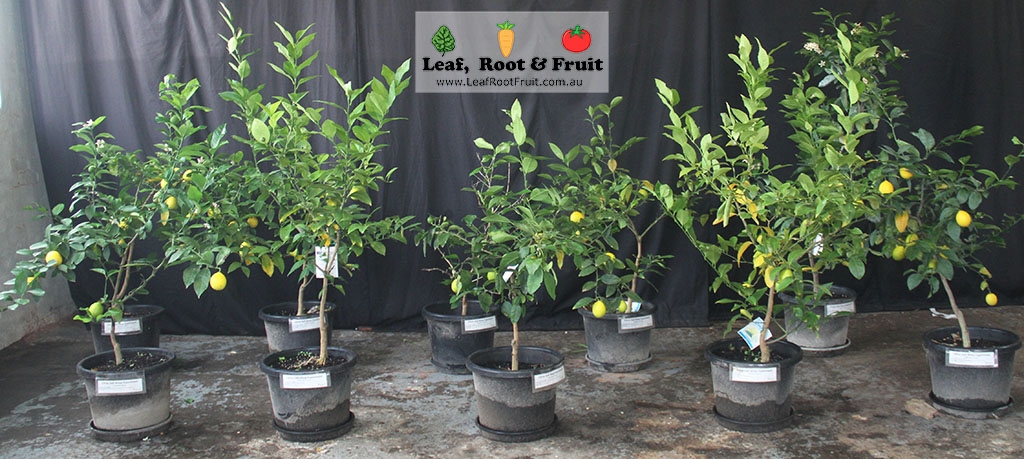
After the initial inspection I performed the “prune in June” to the trees undergoing treatment one and two. I also removed the mature fruit from all of the trees.
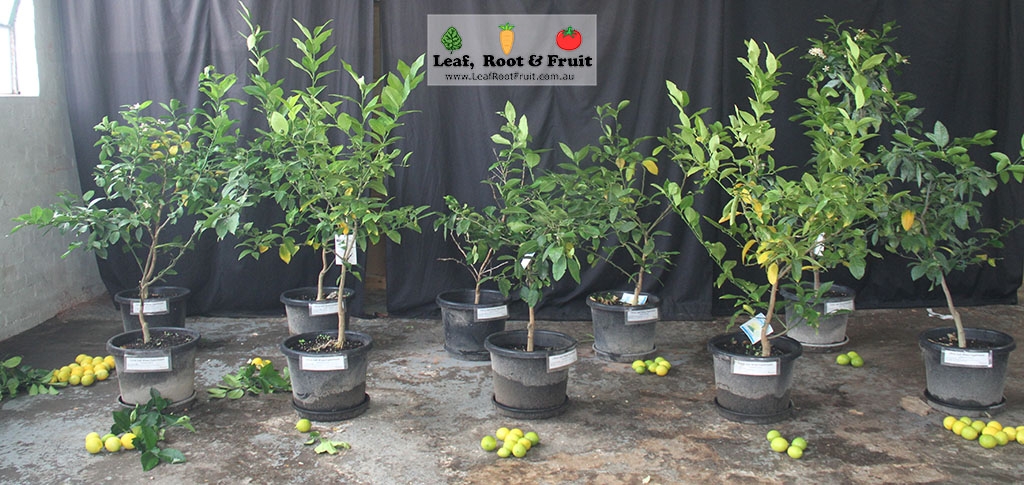
| Tree Number | Number of Citrus Galls present in tree | Leaf Miner evident in Tree | Number of mature, ripe lemons on tree | Total Weight of Crop for both trees (Kg) | Other comments |
|---|---|---|---|---|---|
| 1A | 3 | Moderate | 5 | Flowering, dark green Leaves | |
| 1B | 7 | Very little | 23 | 2.88 kg | Flowering, some leaves yellowing, but mostly dark green. Five immature lemons also present. |
| 2A | 1 | None | 1 | Flowering. Light green leaves with some yellowing. Four immature lemons also present. | |
| 2B | 4 | Very little | 2 | 0.32 kg | Flowering. Light green leaves with scale infestation |
| 3A | 13 | Moderate | 9 | 0.80 kg (one tree only) | Flowering, with dark green leaves. Two immature lemons also present. |
| 3B | N/A | N/A | N/A | N/A | DEAD |
| 4A | 9 | Very little | 4 | Not flowering, very light green leaves with some yellowing. One immature lemon also present | |
| 4B | 12 | Very little | 7 | 0.95 kg | Not flowering, light green leaves with some yellowing |
| 5A | 0 | Moderate | 12 | Flowering, dark green leaves with some yellowing. Kaolin still visible on some leaves. Eight immature lemons also present. | |
| 5B | 0 | Very little | 3 | 1.62 kg | Flowering, dark green leaves with quite a few yellowing. Kaolin still visible on some leaves. Six immature lemons also present. |
Based on the data collated I am reasonably confident that Kaolin can reduce the number of galls present on citrus, if it is applied at the right time of the year. This is clearly shown in the following chart.
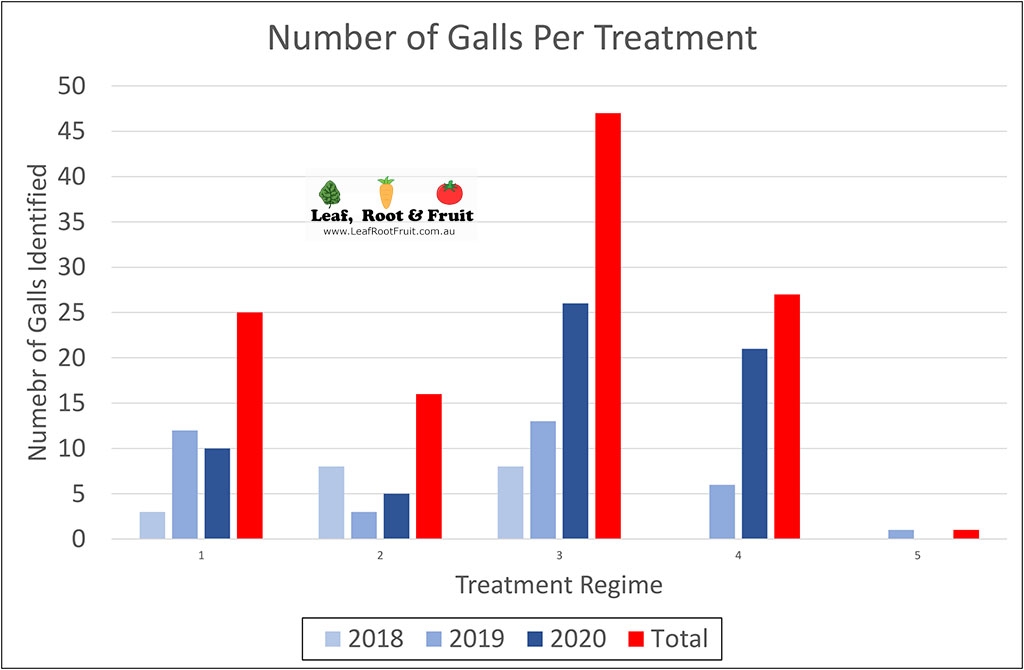
If I am measuring success of treatment regimes as the number of (or absence of) citrus galls, then the Kaolin treatment has been most successful. However, if you also consider the productivity of the tree then you can see that two other regimes are also quite successful (One and Three).
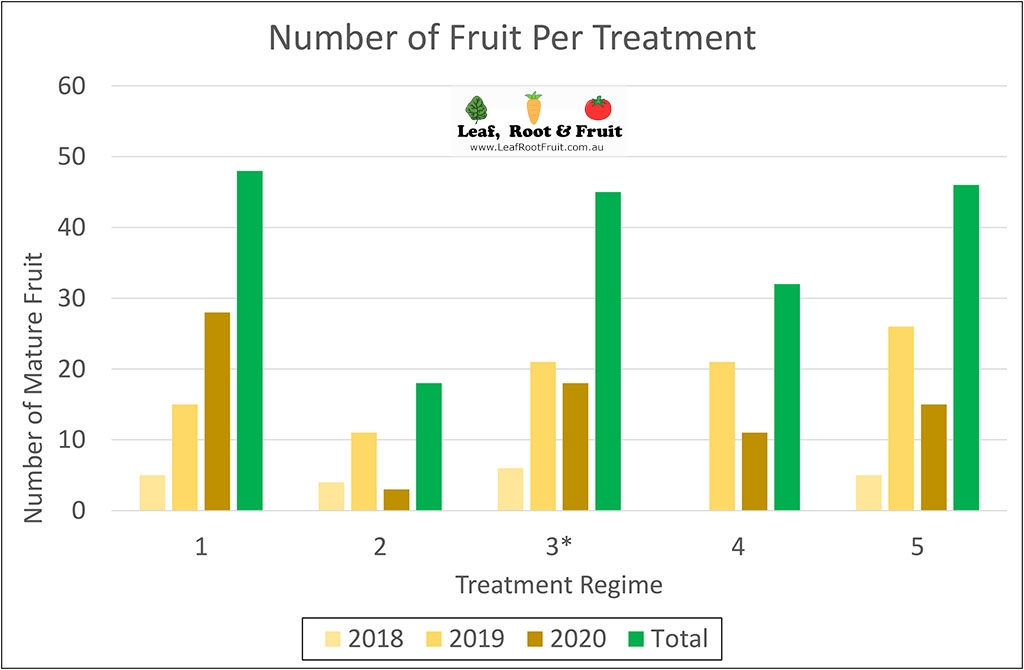
In fact, if we compare the total number of galls vs the total number of mature fruit picked, we can see that there is no correlation. That is, even the trees infested with galls (Such as treatment three) are still as productive as trees with very little galls (treatment five).
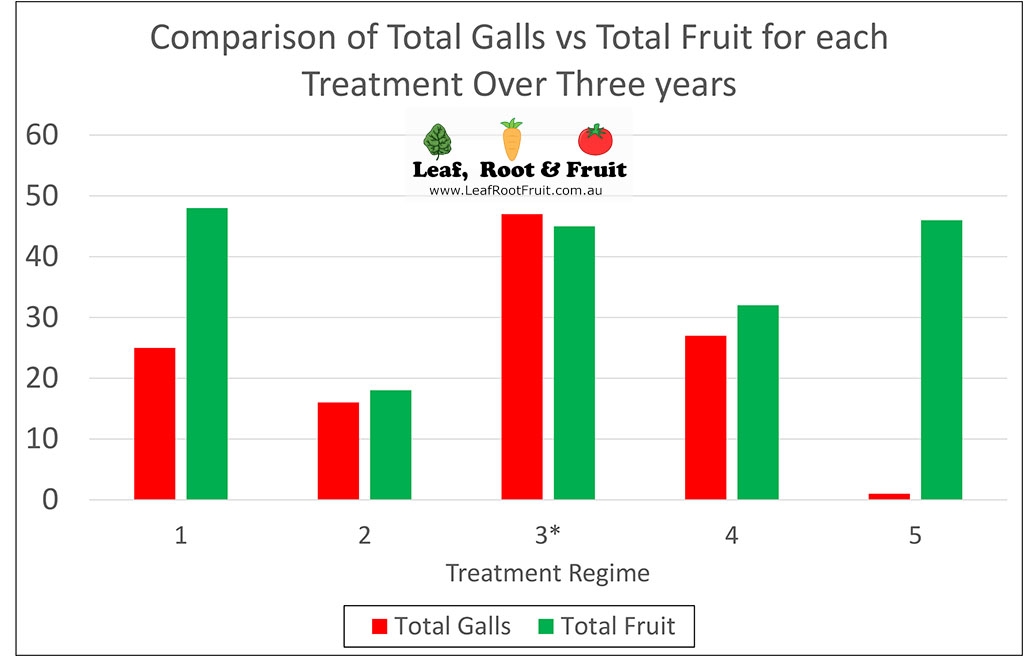
Treatment One, Three and Five are by far the most productive treatments. All three of these treatments involved the heavy fertilising regime (fertilising monthly, September through to May inclusive). The other two regimes, that had much less fruit over the last three years were subjected to the light fertilising regime (December and January only).
So what does all of this data from the last three years possibly indicate?
- You need to fertilise your trees regularly if you want more fruit.
- It doesn’t matter if your tree has galls or not, they can still be productive (as long as you follow point 1).
- If you want to prevent gall wasps from infesting your tree (despite point 2), then kaolin clay looks to be a promising method to do so.
A final update
In late 2020 I finished the commercial lease on the Leaf, Root & Fruit warehouse in Burwood. I don’t have Citrus Gall Wasp in my garden here in Kyneton. So I made the tough decision to abandon this experiment rather than infest my otherwise healthy and productive fruit trees.


My lemon tree is in the east of Melbourne and the gall wasp population is growing year by year. I do not believe June is the correct month to prune. Take this year I had to prune now to prevent them escaping the tree bark. While pruning a flying gall wasp landed on a branch which I squash with my finger. I don’t believe it came from my tree as they were not hatching out, but from some one else’s tree. With the dry weather maybe the wasps have multiple cycles in a year now ?
Hi Martin,
It is interesting that you say you’ve noticed gall wasps emerging now. I’ll keep an eye out on other trees to see if I can also spot some. Perhaps your flying gall wasp was another closely related species rather than the citrus gall wasp?
Thanks for sharing your experience
Duncan
thank you for your time in this matter i will be intrested to now if you have tried taping the affected branch as so the little bastards cannot escape?
Hi Murray,
Thanks for your suggestion. No we haven’t tried this. Our efforts have been focused on preventing infection in the first place. If you trap the wasps inside the branch, then the tree is still susceptible to attack from wasps emerging from other trees. It’s also going to be very labor intensive. If you do trial this method, please let us all know how you get on.
Good Luck and Happy Gardening!
Duncan
Hi, Any idea where can I find Calcined Kaolin Clay (Surround®) in Melbourne? Thanks
Hi Jasmine,
We got ours from a large, rural horticulture supplies. We had to buy it in bulk. We’ll be offering small bags of kaolin clay for sale at the upcoming Spring Into Gardening Festival, where we will have a stall.
Hope to see you there!
Duncan
Your experiment is going to be fabulous and intriguing to follow.
I decided a couple of years ago to reduce heavy Spring feeding as many pests love that sappy Spring growth
– aphids, citrus leaf miner, citrus gall wasps, scale.
I have just liquid fed our citrus which are in the ground with Powerfeed flower And Fruit.
We will sprinkle a light amount of Sheep manure around the outside of the drip line of these trees.
Sheepmanure is low in Nitrogen. Sometimes they get worm wee.
I’ve decided a little feed more often is better for all of our garden plants and maybe we are
Encouraging pests & viruses with heavy feeds.( & overwatering). Maybe we have all become too enthusiastic
(& gready!) with lots of Fertilizer.
I’d like to get hold of some of that Kaolin clay.
Is it available to purchase in Melbourne?
Best wishes for your experiment. I look forward to following the results.
Cheers Marlene
Hi Marlene,
Thanks for sharing your insights and experiences. I agree, heavy feeding your trees is akin to feeding them junk food.
We got our Kaolin clay from a large, rural horticulture supplies. We had to buy it in bulk. We’ll be offering small bags of kaolin clay for sale at the upcoming Spring Into Gardening Festival, where we will have a stall.
Good Luck & Happy Gardening!
Duncan
Where can I get a bag of Surround WP Crop Protectant? Thanks
Hi Jasmine,
We got ours from a large, rural horticulture supplies. We had to buy it in bulk. We’ll be offering small bags of kaolin clay for sale at the upcoming Spring Into Gardening Festival, where we will have a stall.
Hope to see you there!
Duncan
I have tried Calcined Kaolin Clay (Surround®) on my 10 years old Eureka lemon on 23.10.18
I’ve noticed that my new growth leaves were badly affected/burned.
I think it only happened to actively growing leaves – they curled up and and will most likely die.
I used the recommended rate of application – around 30 ml per liter of water in a 5 liter sprayer tank.
Any idea what could go wrong?
Hi Serge,
We haven’t had that experience at all, even on new growth on young plants. Had the sprayer previously been used for any other products (eg weed killer, copper sulphate?). Perhaps some residues were left which have harmed the leaves?
Can you please email some photos through to us as info@leafrootfruit.com.au so that we can see the extent of the damage?
Thanks for the update
Duncan
Hi Duncan,
I did use the spraying tank for feed & weed product on my lawn just before but I thoroughly washed it afterwards.
I will make some photos and post it to you.
Regards,
Serge
Hi Serge,
The weed’n’feed residue must still be in the sprayer. If I were you I would have two sprayers, one for weed’n’feed and one for less toxic applications. I hope your tree recovered.
Jenny
Great citizen scientist analysis, I live in northcote Melbourne. Over the last 20 years galls are now growing on orange trees and not just lemon trees.
My observation over many years is that galls don’t grow on citrus trees at seaside areas of Victoria. Could salt air be a deterrent to galls?
Harry
Hi Harry,
Thanks for the feedback. I’ve seen many galls on trees in seaside areas and hadn’t noticed the same correlation that you have. I’ll now pay more attention though and see if I can spot a similar trend. Perhaps the milder climate impacts their life cycle?
Good Luck & Happy Gardening!
Duncan
Hi,
Just wondering if you’ve noticed if the citrus gall wasps have hatched this year yet?
My trees had a couple of galls but they still seem intact.
Thanks
Libby
Hi Libby,
Our gall wasps started to emerge on December 2nd and many people in Melbourne had them emerge around the same time. They continued to emerge over a prolonged period of several weeks. That being said there are many galls on our trees with undeveloped wasps in them. I wondering if they were eggs that were laid that weren’t fertile? Of if they didn’t develop for some other reason.
Good Luck & Happy Gardening!
Duncan
did you keep an eye if parasitoids emerge from these galls?
No I didn’t.
I live in the Outer East of Melbourne. I have a dwarf Lisbon lemon and a dwarf Eureka lemon. They were in the original pot I got them in from the nursery for about 18 months, No galls while in the pots, but some leaves chewed off by some type of caterpillar. I planted them in especially built raised beds in November 2018. (We have heavy clay soil.) I fertilised them infrequently while in the pots, but once planted out have given them Dynamic Lifter and watered with seaweed solution. Now (early Jan 2019) each tree has several small galls. There are a few immature lemons on each tree above the galls. If I prune these out I will lose the fruit and the trees will be mere sticks. The trees don’t look particularly healthy as the older leaves are yellowish, though the new growth is green and healthy – just what gall wasps love, I hear.
Having read through the articles and suggestions I am still not sure what to do.
Hi Jennifer,
Thanks for sharing your experience. I can understand why you are still unsure of “what to do” about the “problem”. We are eagerly awaiting the outcomes of our citrus gall wasp experiment as the rest of you. In time a clearer management strategy should be evident. Stay tuned!
Good Luck & Happy Gardening!
Duncan
Many thanks for setting up this experiment;
Thanks for the feedback Russell!
Can you please update the results of this experiment for those of us not on Facebook? I have galls on my Kaffir Lime in Croydon (VIC) and am looking to see the best way of dealing with them (and hopefully not infect my new lemon, lime & native ginger lime!)
Hi Megan,
Thanks for your interest. Next week we will be performing our “prune in June” on the relevant trees and then putting together an update after that. We will have the trees on display at our next community night if you would like to see the trees in person. Details can be found on our events page.
Stay tuned and thanks for your patience!
Duncan
Thanks for documenting and sharing.
My concern is that if you have trees that are not being pruned then they will be the hive incubators and keep infecting the nearby pruned trees. I understand that having them far away from each other is difficult but having the two populations close together in my view is unfair when comparing the results.
I raise this because my neighbour pruned very hard on a mature tree and now it’s looking great hardly any wasp and full of fruit. My mature tree just kept getting worse and unmanageable so I decided to remove all the green 28 June. I believe by culling all of the population on my tree it will help reduce infection when fresh green shoots start.
David
Hi David,
Yes, pruning all the galls from your tree will reduce the local population load. However, the wasps are so prevalent in Melbourne that eradication will be impossible.
Pruning your tree makes it more susceptible to attack from neighboring trees. Hence why we advocate for not pruning. Hopefully this expeirment will give us some clarity over the years to come.
Please keep us all updated on the outcome of the hard pruning that you gave your tree.
Duncan
Hello
I’m late to this experiment, but will follow your results with interest.
I have about 15 citrus trees in my garden, (a mix of lemon, mandarin, grapefruit – even a finger lime) all of them are young and very susceptible to gall wasp.
Last year I used the yellow sticky traps but with very limited success. I pruned where I could and probably too early but I’m hoping that maybe the damage they do won’t be too detrimental.
I obviously missed the opportunity to buy the clay from you at the Spring into Gardening Festival last year and won’t be in the country for the next. Very annoying, I would have loved to come, but hey, some of us have to holiday in Thailand!!
I’ve googled calcined kaolin clay to find stockists. It seems there are stockists in US but not sure about import regulations. Any advice on finding Melbourne stockists?
Many thanks
Pat
Hi Pat,
Thanks for sharing your experience with us all.
As it gets closer to being needed we will be making small sachets of Kaolin available for purchase at our community nights on the first Thursday of the month. See our events page for more details on these.
Good Luck & Happy Gardening!
For those interested in buying small amounts of Kaolin, Vasilis Garden sell what they call Citrus Gall Wasp Spray 600g for $49. {maybe a money making opportunity for Duncan to set up in competition with VG!) They didn’t say what was in it so I asked and it is just the clay. I did buy some when they had a special deal going at a reduced price and free postage.
I plan to use it this spring on my trees. If it is successful I will buy in bulk next time. I emailed AgNova to find out where to buy it and they said ” You can buy Surround at Landmark in Wandin North, Elders Limited in Pakenham, Hoogies in Yarra Glen or at any EE Muir & Sons outlets around Melbourne ” pack size is 12.5kg
Contact them on info@agnova.com.au if you need advice for where to buy in your area.
Hi Jennifer,
Thanks for sharing that info.
As it gets closer to being needed we will be making small sachets of Kaolin available for purchase at our community nights on the first Thursday of the month. See our events page for more details on these.
Good Luck & Happy Gardening!
Duncan
Hi I was wondering whether you can just use pure Australian Kaolin Clay (non calcined), known as Eckalite or Eckaglass. You can buy it in bulk from pottery supply stores in Melbourne at a much cheaper price. Checked some US websites they say can use as a truly organic alternative to Surround. Apparently has been used as an organic pest control for many years. Also effective on leafy green crops and tomatoes (so the websites say, I haven’t tried it personally).
Hi Nicole,
I have no experience with that product, but it will be great if it works well without harming the tree. Please let us know how you get on with it.
Good Luck & Happy Gardening!
Duncan
Thank you Duncan, very useful info
Thanks for the feedback Vlad!
Fascinating, Duncan! Thanks for taking the time and effort to test the different pruning/fertilising/treatment regimes.
Thanks for the feedback Olwyn!
Thanks for the update Duncan!
I have an infested Kaffir Lime that I pruned last year, however, having read your experiment, I think I might try the kaolin clay. Two questions;
1. As we use the leaves in cooking, is it enough to wash the leaves before using, or would we not be able to use the leaves with this treatment?
2. Should I prune before applying or leave the galls intact?
Thanks for your help
Megan
Hi Megan,
The surround (R) product is used in the horticulture industry to prevent sunburn of fruit. Thoroughly washing the leaves with water should remove all of the residue.
We are not bothering to prune the galls at all. We simply apply the Kaolin in mid-November, the start of December and mid-December.
Good Luck and Happy Gardening!
What type of sprayer will cope with the clay particles for an urban garden.
Kate Jenkinson
Hi Kate,
The Kaolin clay that we use is very fine and readily suspends in water. Most sprayers that you buy at the local hardware store would be fine.
Good Luck & Happy Gardening!
Duncan
A great experiment, especially for me as we have just returned to Oz after 40 years away and our first action was to plant a lemon and a lime. Last summer/autumn we were troubled by leaf miner but galls do not appear to be an issue yet.
Re your experiment, I have some observations / comments
I suspect that the ‘Prune in June’ strategy’s impact on reducing the number of galls (pairs 1 v 3 and 2 v 4) is not actually being tested.
I assume the strategy relates to citrus trees in an isolated garden and that the wasp (allegedly) does not travel very far i.e. reducing the number of wasps emerging on a tree reduces the number of galls on that tree next year. However, in the first year all your trees were placed in the same position relative to a grapefruit tree with galls i.e. they all had the same exposure to wasps. In the second year pairs 1 & 2 were left with all the others so all had the same growing conditions but it meant they were exposed to wasps coming from the other trees. As pairs 1 and 2 have less branches from which to shoot, they may have less growth so a tendency for fewer galls: note totals for pair 1 v pair 3 are 12 v 13 and for 2 v 4 are 3 v 6 i.e. similar for pruning or not pruning.
Hence all ‘Prune in June’ is being tested for is size of tree and yield rather than reducing infestations by pruning out galls.
Clearly, reducing fertiliser reduces the number of galls as pairs 2 and 4 are the second and third lowest numbers with full fertilising (pairs 1 and 3) being much higher i.e. totals for pair 1 v 2 are 12 v 3 and pair 3 v 4 are 13 v 6. However, kaolin treatment appears to be an even better option without the potential for growth and yield reductions. A very important conclusion.
Re leaf miner: in 2018 pair 3 was the second least affected (with the kaolin treated pair being lower) and in 2019 pair 3 was the least affected (with the kaolin treated pair matching the other pairs). Could it be that max canopy plus max fertiliser of pair 3 caused ‘tougher’ growth (and small fruit size) that made them less attractive to leaf miners? If a reason for set 3 having significantly less leaf miner damage can be found that would also be of great interest.
As regards kaolin and leaf miner, the promise of 2018 was not repeated in 2019. It would be interesting going forward to rate the trees monthly on leaf miner damage to see if set 5 deviates from the others after the start of kaolin spraying. If so, then is it possible that additional kaolin sprays might be useful for leaf miner control as well as galls?.
I have noted that pheromone traps are available for both gall wasp and leaf miner moth and have used the leaf miner one with good success last summer/autumn. Have you tried these?
Hi Colin,
Thanks for your extensive response.
The strategies are not designed to test trees in isolation. They are not in isolation and we are deliberately placing several heavily infested citrus trees nearby to ensure they are not in isolation. Instead we are testing the treatments and how well they prevent infestation in the first place, in any garden situation.
You are correct in observing that kaolin clay is looking the most positive influence on reducing gall wasp infestation. I like the way you have summarised the findings for us there.
I suspect that kaolin will be useful for many other garden ‘pests’, including leaf miner. They key would be applying another dose in late January, just before peak leaf miner season. At this stage we won’t be altering the experiment as we would like to keep the focus on the gall wasps.
Thanks again for your feedback
Duncan
Is it possible to buy a small amount of the kaolin clay? I’ve been watching your experiment and it seems the best way to go. I only have one lemon tree, so couldn’t buy in quantity.
Hi Hazel, we’ve been selling it at our community nights (1st Thursday of the month @ 7pm)
Hope to see you there sometime
Duncan
I’ve finally got my hands on some Surround Kaolin clay and plan to spray my citrus soon. I was wondering though if you have any thoughts on what to do with trees that are in flower?
My Meyer lemon is covered in buds that will open soon, the orange is in bloom and the mandarin is developing buds but they’re a way off flowering. I’m not sure if the clay will be a problem for buds, but I imagine that getting the clay on open flowers will be problematic for pollinators. Do you try to exclude flowers when spraying?
Hi Drew
Yes, if the spray were to coat the inside of the flowers, then the bees would be less likely to visit them. The clay itself is non-toxic and unlikely to kill the bees, simply act as a deterrent to the bees. Citrus trees do not need cross-pollinating. In fact when citrus trees are cross pollinated the fruit usually contains many seeds. So it may in fact, the kaolin may enhance the quality of your citrus fruit by reducing seeds.
We just spray the whole tree from top to bottom and the results show no negative impacts on fruit thus far.
Good Luck & Happy Gardening
Duncan
Just wondering what you think about the sticky yellow gall wasp traps as a method of combatting gall wasp?
I’m in Cheltenham in Melbourne and I usually just prune the galls out around September, but this year considered buying the traps. But at $10 each it would be good to know that they were worth it.
Hi Annette,
We really don’t encourage them. Not only do they catch gall wasp, but also many beneficial insects in your garden.
Good Luck & Happy Gardening
Duncan
Hi all. Bulleen Art and Garden have the kaolin clay in stock at the moment. Perfect timing for this years emergence.
Thanks for the tip Leanne!
This is so interesting. Thank you
Thanks for your feedback Linda.
Good Luck & Happy Gardening!
Interesting article. I tend to cut Gall Wasp out whenever I see them and feed in Spring and Autumn. My Meyer 🍋 is about 65 years old and still producing, as of now October 2019 it is covered in Blossom and looking forward to big crop.
Thanks for your feedback Christine.
Good Luck & Happy Gardening!
Duncan,
First of all, thank you for running this experiment as it is quite interesting to see the effects of the different treatment / fertilizing regimes over time. This is really valuable information.
Can I get your feedback on the following hypothesis and potential flaws that I am missing.
Running an experiment where you use Surround on 20% of your trees while the others do not have such a deterrent can be compared to providing 4 plates with fresh ham and cheese sandwiches and one plate of just stale plain bread and asking a group eat. 90% will pick the the tasty sandwiches, while 10% don’t like ham or cheese and hence select the stale bread.
The issue I see arising with an experiment where there may be 4 confounders influencing the outcome, is that if the untreated trees cease to be an option for gall wasps due to long term infestation killing them, the infestation of the Surround treated tree may increase as the galls have less options.
The reason I have this hypothisis is that I have had many cases where these gall wasps freshly infected older branches rather than fresh growth as the tree was in very poor health with limited new appealing growth. The tree appeared to be dying due to excessive infestation.
My concern is that if the gall wasps only option is to lay eggs in a tree that has been treated with Surround and the galls are not pruned, the infestations may increase to more than just a 10% infestation rate over time, given there are no other options.
If a wasp lays up to 100 eggs and the galls are not cut out, even with a 10% infestation rate and 20% hatching rate, over a period of 5 years that could at worst case lead to an outcome of 62 wasps hatching during the 5 year period and rising to 1024 hatching in just year 10 alone.
This is my reasoning for cutting back on galls and as of this year treating the tree with Surround. I figure that any galls I prune out, I have less of a population to try to infest my and other neighboring citrus trees (acknowledging that there will be increased fresh growth), however I also treat my trees with Surround so they will be seen as the stale bread that no one wants.
What are your thoughts?
Would it be possible to introduce a tree you prune and treat with Surround to see if the infestation of new growth can be reduced in a similar fashion as your trees that you don’t prune?
Also, what are your thoughts on spraying the Calcined Kaoline Clay when the citrus trees are flowering? I have read some suggestions that this should not be done for concerns with bees.
Hi Roland,
Firstly thank you so much for taking the time to outline your thoughts on this experiment. As someone with a background in science I value such input.
All your points are very valid and I’d love to expand the trial and make it more robust. If space wasn’t an issue I certainly would have included more replicates of each treatment. However, this experiment has been set up by a small, family run business with limited time, budget and space. Other than a bit of social media coverage, we don;t receive any return on this investment, other than knowledge itself.
When I set up the experiment, I had no idea of the outcomes. The kaolin clay was added to the experiment merely as an afterthought. I hadn’t expected it to have such a positive outcome for this treatment.
The experiment has been running for three years now. So it is impossible to simply add more trees or treatments without adding further bias into the trial. It would have to be started again. If someone has the space (and water) to grow 25-50 citrus trees and can find funding to set the experiment up, I’d certainly be keen to assist where I can with setting up and monitoring the experiment.
As for spraying during flowering, then yes, if the spray were to coat the inside of the flowers, then the bees would be less likely to visit them. The clay itself is non-toxic and unlikely to kill the bees, simply act as a deterrent to the bees. Citrus trees do not need cross-pollinating. In fact when citrus trees are cross pollinated the fruit usually contains many seeds. So it may in fact, the kaolin may enhance the quality of your citrus fruit by reducing seeds.
Once again thanks for your thoughts and feedback.
Duncan
Interesting experiment. Has anyone investigated a treatment to prevent hatching rather than prevent infestation (assuming the tree is self-infesting rather than a victim of neighbour’s wasps). I was thinking of perhaps covering the galls with wax or varnish, something they can’t burrow through?
I’ve been nursing an infected tree back to health for 5 years now and fruit is increasing every year, but each time I prune off galls it gets thinner so I’m wondering if it’ll ever flourish again. My method has been to remove all infected branches by October and hang wasp traps. My neighbours have very healthy trees and no galls that I can see!
Hi Richard,
There are many methods people have been trialing to treat the issue in established trees. In my opinion all of them seem very labour intensive and futile. Instead we are focusing on prevention of infestation in the first place. Gall wasps emerge on hot days in Melbourne, which often coincide with a strong northerly winds. Therefore, I suspect they can move several kilometers south with these winds. So it’s not just your immediate neighbours you need to worry about. Hence the focus on prevention rather than treatment.
Please keep us all updated on your progress
Duncan
Is this the right time now to apply Kaolin Clay?
Cheers,
Serge
Hi Serge, the spray needs to be applied prior to gall wasp emergence. In 2017 that was in late November, in 2018 early December and this year it will also be early December. Hopefully with a few more years of experience of observing gall wasp emegrence in Melbourne we can more accurately predict emergence. For the time being though, it’s probably best to start spraying from early to mid November.
Good Luck & Happy Gardening
Duncan
Just wondering if it’s a good idea to mix white oil with Kaolin clay and then spray that mixture.
Would Kaolin clay attach better to the leaves and branches and so make it feasible to avoid multiple applications?
Regards
Serge
Hi Serge, it seems to attach pretty well without the oil. My concern with adding the oil would be that the clay may become a paste rather than a powder. I suspect the clay works best as a powder as it would stick to the wasp and not allow it to access the tree bark properly.
Hope that helps
Duncan
Thanks for doing this work. I will be sharing your information with the Macleod Organic Community Garden where we have 12 citrus trees.
Thanks for your feedback Robin. Good luck with the community garden!
Got a 2020 update? I’ve been waiting with baited breath!
Stay tuned Paul. Good things come to those who wait!
Had a look at my lemon today and found some galls I’d missed and was surprised to find no emergence holes, given today is February 3rd in Melbourne. After removing the galls I stripped the bark and found a lot of small bumps which I assume were larvae and one mature wasp which seemed dead. This lack of emergence seems to happen on all my container grown citrus. Any idea what is going on?
Hi David,
I see this a lot, and am wondering if it is infertile eggs being laid and not developing?
Just a hypothesis mind you!
Duncan
I found the same thing from spring 2019. I left a few galls on the tree and sprayed occassionally with citrus oil. I couldn’t see any emergence holes on any of these galls. Not sure if the citrus oil worked. My other theory is that last spring in Melbourne was very cold. Then suddenly it turned to summer and we had a very hot stretch of days. I wonder if this mean that by the time it was warm enough for the wasps to emerge, it was already too hot for them and they died inside the galls?
Thank you for your effort and willingness to share in this subject that plague many backyard gardening enthusiasts. I have learnt a lot from here. Big THANK YOU!
Thanks for the great feedback Wing!
When is a good time to prune off galls in Melb? Would early November be ok, right before the wasps emerge?
Would this timing allow the fresh regrowth to appear after the wasps have been and gone?
I’m assuming 1-2 months for any new shoots to appear.
Hi Andrew,
That’s a simple question with a complex answer. You could prune in November, which in theory wouldn’t have time to stimulate new growth for the wasps to attack. However, in doing so, you’ll also prune off all the developing fruit. Not such an issue for say, a lemon tree, which will just flower again, but will have a larger impact on an orange tree. There’s no perfect time to do such a thing, just different times, with different consequences!
Unfortunately I can’t be more specific about timing of pruning. My advice would just be to leave them there.
Stay Safe & Keep Gardening
Hi there,
In this covid-19 world we are in, is there anyone that sells Surround in smaller quantity yet, that you know of? one that preferable delivers/posts?
Thanksfor any help.
Woz
Hi Warren,
If restrictions allow we will arrange one day for people to visit us and collect small bag. It will likely be in early November. Stay tuned to our newsletter and social media for an update on this.
Stay Safe & Keep Gardening!
Duncan
Hi Duncan,
Thanks for the reply. hopefully by then we can move about lol
Regards,
Woz
Kaolin Clay is available in 500g bags from Senior Art. It appears to be the same product although I have yet to test it.
It can be purchased online below…
https://seniorart.com.au/index.php?main_page=product_info&cPath=419_422_424&products_id=1001343
Heya – just wondering what size ‘spoons’ you are using to measure the 8 spoons of clay with the 2litre mixture – is it teaspoons/tablespoons etc? First time trying the Kaolin method this year. Many thanks! Hayley
Hi Hayley,
Usually tablespoons, but don’t over think it. As long as you end up with some white water, and a white tree once you’ve sprayed it on, it seems to be effective!
Hi and thank you so much for your gall wasp experiments and all the follow up.
We moved from inner Melbourne several years ago and the first gardening item was to plant a baby lemon tree. In Kew, we had grown lemon trees in the back garden and then tried the front garden, but every year they would get infested no matter how much we cut the galls out. We assumed that there was a tree somewhere nearby that was the source of new infestations. So we were most disappointed to spot some galls on our new baby lemon after about 6 months.
Then I found your article – yeah!
I am now getting ready for this season – the young tree has a couple of galls in position where we lose most of the tree if we cut them out. So having armed myself with clay from Bulleen Art and Garden, I am just revisiting your site to determine how and when to do the treatment.
I see you have said to mix 8 spoons of powder up into a 2 litre mix. The photo looks like a teaspoon, but I just want to check as tablespoons hold a fair bit more than teaspoons. Teaspoons or tablespoons? Or doesn’t matter?
And is this correct : first spray mid-November, then start December and again mid-December? Fully cover the tree, but avoid flowers if there are any.
Another question – what is the best lemon tree food to use? I find that if I use a little too much of citrus specific food, there is a lot of large floppy leaf growth, which is not what you want. So have cut back on that. Also has warnings about not to feed when flowering, and there are always a few flowers on the tree.
Thanks in anticipation of some expert feedback! 🙂
Jo (a most ignorant but enthusiastic gardener)
Hi Jo,
Thanks for your questions.
In terms of spoon size – it doesn’t really matter so long as the spray is white and the tree is white at the end.
Give the wasps are emerging from mid-November in some years, than just prior to that would be a good idea. The wasps are emerging as late as mid to late December in some years, so keep any new growth white until Christmas.
In terms of fertilizing, we use the Richgro Organic fertilizer in the experiment and that works well. We’ve had the best results giving a handful every month in spring, summer and autumn. You can see the outcomes in the various updates we have posted in the blog post.
Good Luck with it all
Duncan
So relieved about your results! It gives me peace of mind that my lemon tree with its heavily swollen branches and knots may continue its life as gall wasp metropolis even though I panic-pruned it in June. It still delivers lemons of an acceptable quality, and I’ve always had too many anyway.
BTW I like a solid scientific approach, it gives you the choice what you would like to achieve: not sure if the sprayed tree looks prettier even if it has hardly any galls.
Thanks for your good information; and your chook video is just hilarious!! Group-dynamics can be studied here: a chook – sociogram!
Hi Claudia,
Thanks for the great feedback. I’m glad you found it useful.
Good Luck & Happy Gardening!
Duncan
I have three, Tahitian limes, one lemonade lemon, rats stripped o lot of bark from 2 of the limes, but having got rid of the rats they are both starting to grow back, all trees have galls but the lemon and the other lime produce fruit in great quality and quantity!, they are fertilised with B/B and D/L at various times during the year, all trees are about 5/years old so I am following your experiment with interest and the Clay seems the way forward!, Murray Smith.
Thanks for the feedback and for sharing your experience Murray.
Good Luck with the citrus trees!
Hi there, I am wondering if the spray needs to be applied to every part of the tree, or just to the new growth? ( I seem to have turned everything in the vicinity white.)
Hi Adele,
Yes, the down side of kaolin is that everything turns white. The good news is that after a few heavy rainfall events it all washed into the soil.
The wasps seem to lay their eggs particularly on new growth.So that is where I would focus you efforts.
Good Luck & Happy Gardening!
Hey thanks for sharing this experiment. I found it fascinating, easy to understand and to emulate. I am really curious to read how those trees continue to grow and produce over the life of the experiment.
Thank you!
Hi Helen,
Unfortunately, for various reasons we have had to discontinue this experiment. Fortunately we got some good data and feel confident that the kaolin clay is the way forward for controlling citrus gall wasp.
Good Luck & Happy Gardening!
Duncan
Thanks for the information published. I am an amateur garderner and just used the kaolin clay for the 1st time today after purchasing it from BAAG. I had lots of questions regarding the instructions as I was in the middle of spraying. I am hoping others can help enlightened me. I have an established Lemon Meyer tree that is about 2-2.5m tall and am mainly concerned gall wasps.
1) Do I spray the whole tree including leaves or only on the branches/new shoots?
2) Instructions says not to spray on flowers but a lot of the new shoots are near flowers. It was difficult to control and finally I just gave up and sprayed everywhere. Any tips on how to do better? How much should I worry? A lot of the flowers were still budding
3) Since the wasp emerge from the ground should I focus on the lower branches or go for the top branches too?
4) I have about 300-400ml leftover of the solution with. I have gotten mixed information regarding reusing it within a 2 week interval. Can it be reused and if not what is the reason
5) Why have you chosen to increased the application rate to fortnightly?
Thanks for any comments
Hi Chiang,
We simply spray the whole tree from top to bottom, including flowers and all seems to be fine. Once the spray is dry, the whole tree should be white. Repeat spraying when the new growth is visible without any spray on it. It is the new growth that they prefer and will infect, so you need to keep it covered. We have stored the solution for several weeks and reused it without issue.
Good Luck & Happy Gardening
Duncan
I have read this experiment & responses to it that I have lost what the steps are to treat the lemon tree with Calcined Kaolin Clay (Surround®). Duncan, I have 1 lemon tree & thinking of adding another citrus tree later. So in summary:
1. When is the best time to use kaolin clay? I live in Heidelberg, Victoria.
2. How many times in the year do you spray this clay?
Thanks you.
Hi Pauline,
you need to spray immediately before wasp emergence. Some years that has been late November, other years during December. This year we haven;t had much in the way of gall wasp updates from the public. Either thy have lost interest, or the wasps didn’t emerge or emerged late due to the weird season. Unfortunately we don’t have enough data to make blanket statements about timing etc.
You could try spraying the trees every fortnight from mid-November onwards, until gall wasp emergence has finished (possibly around Christmas time, or even earlier). you’ll need to apply more often if it is raining a lot and the clay washes off. The main thing is to keep the new growth covered, especially the small emerging tips.
Hope that helps
Duncan
JIM..hi what do you think of Confidor spray?. It has good results
Hi Jim, we tend to focus on organic approaches and therefore avoid using confidor spray.
Good Luck & Happy Gardening
Duncan
Merry Christmas everyone,
Just wanted to ask if anybody noticed emergence of the wasps yet.
We had a very cold spring this year so I wouldn’t be surprised if it still hasn’t happened.
Cheers
Hi Serge,
I didn’t receive any reports of gall wasp emergence this year. I’m not sure if folks have stopped looking, or if the crazy season resulted in very little, or no gall wasp emergence.
Here’s hoping it was the latter.
Duncan
This is such an interesting experiment.
Is there any update since June 2020?
Hi Rose,
Thanks for the feedback. Alas, no. When we gave up our Melbourne based depot I had to find a new home for the experiment. My garden in Kyneton is free of them, so I wasn’t keen to relocate them here. The experiment has now been discontinued.
Happy gardening
Duncan